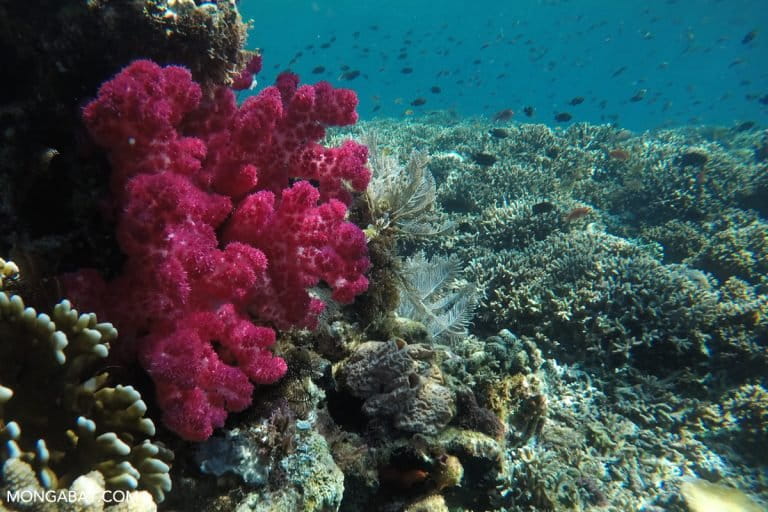- As Indonesia aims to protect more of its seas, scientists say in a new paper that effective management of these marine areas must be the government’s top priority in a world faced with global climate change and biodiversity crises.
- The researchers say that marine protected areas must protect the natural resources, provide long-term benefit to local people, and be equipped with a zoning system, monitoring, surveillance, adequate staff capacity, facilities, and self-financing.
- The Indonesian government has pledged to secure 10% of the country’s territorial waters towards biodiversity protection and sustainable use by the end of this decade, and triple the size by 2045.
- The move is part of the country’s contribution to the global “30 by 30” conservation goal, which aims to protect 30% of the world’s seas and lands by 2030.
JAKARTA — As Indonesia aims to protect more of its seas, scientists say in a new paper that effective management of these marine areas must be the government’s top priority in a world faced with global climate change and biodiversity crises.
The Indonesian government has pledged to secure 10% of the country’s territorial waters towards biodiversity protection and sustainable use by the end of this decade, and triple the size by 2045. The move is part of the country’s contribution to the global “30 by 30” conservation goal, which aims to protect 30% of the world’s seas and lands by 2030.

A group of scientists from around the world supported Indonesia’s commitment, but noted in their recently published report that marine protected areas must protect the natural resources, provide long-term benefit to local people, and be equipped with a zoning system, monitoring, surveillance, adequate staff capacity, facilities, and self-financing.
“It’s becoming increasingly important that we don’t do conservation with our heads underwater, but that we work alongside other sectors to benefit both people and nature,” Gabby Ahmadia, the senior director of Science and Seascapes at the conservation group WWF-US who is a co-author of the paper, told Mongabay in an email.
“There is a real opportunity in Indonesia with the rapid growth across all these sectors – to align efforts to promote sustainable development, sustainable use of marine resources, and the conservation of biodiversity,” Ahmadia said.


The new report outlined the current landscape of Indonesia’s MPAs management, and then described the fisheries and marine tourism sectors within those areas of their challenges and opportunities. It also highlighted global threats affecting the environment and economy worldwide such as climate change and the COVID-19 pandemic.
The researchers said that fisheries and tourism must be included in the management of MPAs for economic benefits, but the activities also bring upon pressures — such as blast and cyanide fishing, mass tourism — to the sustainability of the marine ecosystem. While regulations around fisheries and tourism allowed to happen in MPAs exist, proper enforcement of restrictions and monitoring is highly dependent on human and financial capacity of management bodies at the provincial and MPA levels, the paper noted.
“Unfortunately, MPA development requires significant time, especially for capacity development, and so this is progressing slowly,” said Muhammad Erdi Lazuardi, the national coordinator for marine science and knowledge management at WWF-Indonesia who is a co-author of the paper, in the email interview with Mongabay.
“Thus, effective management of MPAs is still an area requiring further work going forward,” he added.


The researchers said an improved governance and planning of MPAs would include having diversified types of community-based management to increase the sustainability of both the fishery and tourism sectors. They urged the government to develop a particular strategy to minimize the impacts of overwhelming number of tourists beyond an MPA’s carrying capacity amid the anticipated return of tourism to Indonesia after COVID-19 travel restrictions have eased, and also the national priority of tourism destinations, known informally as “the new Balis.”
“It is important to balance the needs of communities as a whole, but also their different social groups (e.g., cultures, genders, ages), that are intertwined with coral reef health, and their current and future vulnerability to climate change,” Maria Beger, the associate professor in Conservation Science at UK’s University of Leeds who is the paper’s co-author, said in the email to Mongabay.
Indonesia currently has 284,000 square kilometers (110,000 square miles) of marine area under protection and the country is home to some of the most diverse marine life on the planet, especially in its eastern region that falls within the Pacific Coral Triangle, an area renowned for its richness of corals and reef fish. A wide range of management strategies are used within MPAs, prohibiting or allowing certain activities that are applied across the MPA or among zones.
Indonesia’s marine biodiversity plays an important role in the domestic and global supply of seafood. However, some expert estimates point out that only about 25% of Indonesia’s current network of marine protected areas has proved effective at conserving fish stocks and biodiversity, and at ensuring equitable benefits for ocean-dependent communities.
“We also wanted to share the Indonesian MPA process with the world, so that important learnings can be used by others,” Berger said. “MPAs can go a long way towards managing the local stressors, and I think that forward thinking in these management efforts is key.”
Citation:
Tranter, S. N., Estradivari, Ahmadia, G. N., Andradi-Brown, D. A., Muenzel, D., Agung, F., Amkieltiela, Ford, A.K., Habibi, A., Handayani, C. N., Iqbal, M., Krueck, N. C., Lazuardi, M. E., Muawanah, U., Papilaya, R. L., Razak, T. B., Sapari, A., Sjahruddin, F. F., Veverka, L., Yusri, S., & Beger, M. (2022). The inclusion of fisheries and tourism in marine protected areas to support conservation in Indonesia. Marine Policy, 146, 105301. doi:10.1016/j.marpol.2022.105301
Basten Gokkon is a senior staff writer for Indonesia at Mongabay. Find him on Twitter @bgokkon.
FEEDBACK: Use this form to send a message to the author of this post. If you want to post a public comment, you can do that at the bottom of the page.